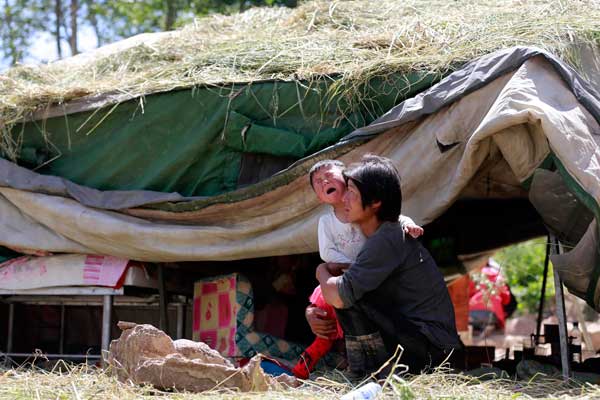Regions and cities
Dingxi city
Updated: 2013-10-17( travelchinaguide.com )
?Name: Dingxi city
Population: 2,960,000
Area: 20,300 square kilometers?(10,425 square miles)
Ethnic group: Han
Administrative Division: 1 district (Anding); 2 counties (Tongwei, Lintao, Zhangxian, Minxian, Weiyuan, Longxi)
Seat of the City Government: No 31, Zhonghua Lu, Anding district
Useful Telephone Numbers: Tourist Complaints: 0932-8212959 Weather Forecast: 121 Zip Code Inquiry: 184
Bank of China Dingxi Branch: No 60, Yongding Dong Lu, Anding district
China Post Dingxi Branch: No 6, Minzhu Lu, Anding district
Overview: The city of Dingxi is located in the central part of Gansu province, 98 kilometers away from the capital, Lanzhou. It covers an area of 20,330 square kilometers in total. There are 18 ethnic groups living in the city. Dingxi sits at the west edge of the Loess Plateau and the end of the west Qingling area. Its altitude runs from high to low from south to north, measuring 1,420-3,941 meters above sea level. Its annual average temperature is about 7 C. Annual precipitation is 400-600 millimeters, and the frost-free period of the city is 100 to 160 days total.
Location: Dingxi city is located in central Gansu province neighboring Lanzhou and Baiyin in the north, Pingliang and Tianshui in the east, Longnan in the south, Gannan Tibetan and Linxia Hui autonomous prefecture in the west.
History: Dingxi, located on the upper reaches of the Yellow River, is an important cultural centre exhibiting more than 2,200 years of history. Several cultural relics of the Neolithic Age have been discovered in the city. It was a flourishing place of great importance on the Silk Road. After the establishment of the PRC, Dingxi Special district was set up and changed to Dingxi Region in 1970, then Dingxi city in 2003.
Physical Features: With the Weihe River as a limit, the city can be divided into the gully area of Loess Plateau in the north and the cold and humid highland area in the south. On the whole, the terrain of Dingxi declines from the south to the north.
Climate: The northern region of the city enjoys a middle temperate semi-arid climate and the south bears a warm temperate semi-humid climate. Strongly affected by its landform and the monsoons, the temperate is higher in the north than that in the south, while the rainfall is quite the opposite. The annual average temperature maintains around 5.6C-7.6C (42.1F-45.7F).
Resources: The earth and weather in Dingxi are good for the growth of Chinese medical herbs and potatoes, which makes the city a potato supply center for Gansu province and other nearby provinces. Dingxi is an important Chinese medical herb production area with more than 300 Chinese medical herbs discovered in the area. Angelica and Codonopsis production in the city accounts for 70 percent and 40 percent of the entire country’s output, respectively. Lintao county in Dingxi is an ideal place for the growth of edible mushrooms of all kinds thanks to its ample sunshine and large temperature variance.
There are many well-known national and provincial forest parks in Dingxi, including Guiqing Mountain, Zheyang Mountain and Lianfeng Mountain. It is also home to some famous ancient cultural relics from the Neolithic Period, including Majiayao (or the Ma Family Cave), Qijia Culture and Siwa. There are also many unexploited scenic spots, including relics of the Great Wall built during the Warring States Period (475-221 BC), running 300 kilometers west from Lintao county; the Li Family Hall, an ancestor worship place for people with the family name Li; and Tongwei Hot Spring.
Economy: In 2011, the city’s GDP reached 18.7 billion yuan ($3.07 billion), a year-on-year increase of 12.7 percent. The added value of the primary industry was 5.29 billion yuan, an increase of 5.5 percent year-on-year. The added value of the secondary industry was 5.18 billion yuan, an increase of 20.7 percent. The added value of the tertiary industry was 8.23 billion yuan, an increase of 13.1 percent.
Living: In 2011, the per capita disposable income of urban people in Dingxi was 12,290 yuan, a year-on-year growth of 13.9 percent. The per capital income of farmers was 3,074 yuan, an increase of 13.8 percent year-on-year. The per capita consumption of urban people and farmers was 8,982 yuan and 3,005 yuan, respectively, marking year-on-year growth of 11.2 percent and 24.22 percent, respectively.
Social undertakings: By the end of 2011, the city had 1,783 schools. The higher education institutions enrollment rate reached 23.4 percent of all applicants, an increase of 2.1 percent compared to 2010.
In 2011, Dingxi organized applications for 182 scientific and technological planning programs at the national and provincial level in total. By the end of 2011, the city had 542 medical and health organizations, providing 9,052 beds for patients. Among the 7,498 medical personnel, 2,209 had professional qualification certifications. In 2011, the city invested over 30 million yuan in enlarging the public sports area by 100,000 square meters, a year-on-year increase of 16 percent.


